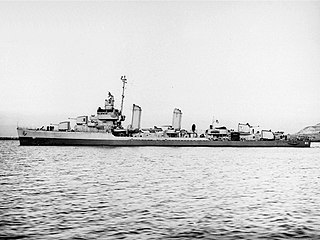
USS Mustin (DD-413) was a Sims-class destroyer of the United States Navy, the first Navy ship of that name, in honor of Captain Henry C. Mustin (1874–1923), a pioneer of naval aviation.

The third USS Farragut (DD-348) was named for Admiral David Glasgow Farragut (1801–1870). She was the lead ship of her class of destroyers in the United States Navy.

USS Chauncey (DD-667) was a Fletcher-class destroyer of the United States Navy, the third Navy ship named for Commodore Isaac Chauncey (1779–1840).

USS Franks (DD-554), a World War II-era Fletcher-class destroyer in the service of the United States Navy, was named after Medal of Honor recipient Acting Master's Mate William Joseph Franks.

USS Ralph Talbot (DD-390) was a Bagley-class destroyer in the United States Navy, named for USMC Second Lieutenant Ralph Talbot (1897–1918), who was awarded the Medal of Honor during World War I. Talbot served in the Pacific Theater during World War II, from the attack on Pearl Harbor through the battle of Okinawa, earning 14 battle stars for her service.

USS Doneff (DE-49) was an Evarts-class destroyer escort which served in the United States Navy in the Pacific Theater of Operations. The only encounter with the Imperial Japanese Navy was the sighting of one or two A6M Zero fighters during the operational time spent in the Aleutian Islands.

USS Fullam (DD-474) was a Fletcher-class destroyer in the United States Navy during World War II. Fullam was named for Rear Admiral William Fullam (1855-1926).

USS Anthony (DD-515), a Fletcher-class destroyer, was the second ship of the United States Navy to be named for Marine Sergeant Major William Anthony (1853–1899).

The first USS Dewey (DD-349) was a Farragut-class destroyer of the United States Navy, launched in 1934 and named for Admiral George Dewey. Dewey served in the Pacific through World War II. After escaping damage during the attack on Pearl Harbor, Dewey screened the aircraft carrier USS Lexington until the carrier was lost in the battle of the Coral Sea; then screened USS Saratoga through the invasion of Guadalcanal and the battle of the Eastern Solomons. Following overhaul in San Francisco, Dewey spent 1943 in Alaskan waters supporting the invasions of Attu and Kiska. Dewey spent 1944 supporting raids in the Marshalls, Carolines, and Marianas, including screening carriers during the battle of the Philippine Sea. After being damaged by Typhoon Cobra during the recapture of the Philippines, Dewey supported the invasion of Iwo Jima and spent the remainder of the war screening replenishment oilers.

The third USS Macdonough (DD-351) was a Farragut-class destroyer in the United States Navy during World War II. She was named for Thomas Macdonough.

The fourth USS Flusser (DD-368) was a Mahan-class destroyer in the United States Navy before and during World War II. She was named for Charles W. Flusser.

USS Downes (DD-375) was a Mahan-class destroyer in the United States Navy before and during World War II. She was the second ship named for John Downes, a US Navy officer.

USS Cotten (DD-669) was a Fletcher-class destroyer of the United States Navy, named for Captain Lyman A. Cotten (1874–1926).

USS Kalk (DD-611) was a Benson-class destroyer in the United States Navy during World War II. She was the second ship named for Lieutenant Stanton Frederick Kalk.

USS Gilmore (DE-18) was an Evarts-class short-hull destroyer escort in the service of the United States Navy.

The second USS Fleming (DE-32), and first ship of the name to enter service, was an Evarts-class destroyer escort built for the United States Navy during World War II. While performing convoy and escort duty in the Pacific Ocean she was also able to sink one Japanese submarine and to shoot down several kamikaze planes that intended to crash onto her. For her military prowess under battle conditions, she was awarded four battle stars.

USS Sederstrom (DE-31) was a Evarts-class destroyer escort of the United States Navy during World War II. She was promptly sent to the Pacific Ocean to escort convoys and to protect other ships from Japanese planes and submarines. Her assignments took her from one battle area to another, but she was fortunate in remaining almost unscathed by the end of the war. For her efforts in battle areas, she was awarded five battle stars by war's end.

USS Dionne (DE-261) was an Evarts-class destroyer escort of the United States Navy during World War II. She was sent off into the Pacific Ocean to protect convoys and other ships from Japanese submarines and fighter aircraft. She performed escort and antisubmarine operations in dangerous battle areas and returned home with six battle stars, a high number for a ship of her type.

USS Straus (DE-408) was a John C. Butler-class destroyer escort in service with the United States Navy from 1944 to 1947. She was finally sunk as a target in 1973.

USS Silverstein (DE-534) was a John C. Butler-class destroyer escort in service with the United States Navy from 1944 to 1947 and from 1951 to 1958. She was sold for scrapping in 1973.




















